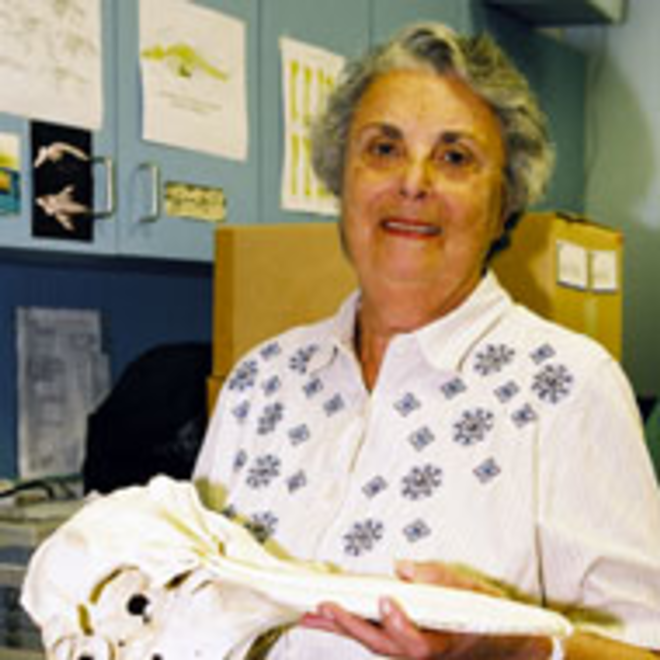
In a tiny paper-strewn office in Sarasota, an elderly woman with salt-and-pepper hair is examining skulls. Just outside, hungry beetles munch on dead flesh. And nearby, a garbage can full of dismembered bodies is emitting a horrific stench you have to experience to believe.A scene from a low-rent horror movie? Backstage at Fear Factor? No, this is the realm of Ruth Delynn, a curator and adjunct scientist with Mote Marine Laboratory whose specialty is cetaceans (or, to us laymen, dolphins and whales). More specifically, she studies dead cetaceans, as she has for the past 20 years at the lab. It's a job, she admits, that few people would envy; in fact, she's not even paid. Yet the work she does — as part of a two-person team that photographs, disarticulates, guts and skeletonizes dead animals — is crucial to cetacean research.
"The animal comes in on the truck," she says, leading me on a tour of the operation. We enter a large white room, a necropsy lab resembling a four-car garage-turned-chicken processing plant overlooking Sarasota Bay. It's just a few yards away from the water. "It goes on a stretcher and gets weighed," she continues, "and everything gets recorded."
We walk outside to a concrete platform, a few feet square, located next to a utility shed. A bathtub, a big drain, some red and gray garbage cans, and shelves resembling baker's racks all sit inside a fenced enclosure. The temperature's approaching 85 degrees, and it is only 10 a.m.
"The bodies go into the red barrels, the heads go into the gray barrels." The parts are separated for an obvious reason — a whole dolphin won't fit inside a single garbage can.
The process, understandably, stinks. The carcasses are soaked in water for days (much longer during winter months), allowing bacteria to do the work. Small oxygen-filled tubes keep anaerobic sulfur bacteria from forming a goopy mess.
When I ask, somewhat sheepishly, why each can is marked "BUG" in black permanent ink, Delynn quips, "because they're mine. They call me the bug lady."
Shortly after, I find out why. Her colony of dermestid beetles, found commonly eating carpets and roadkill, is responsible for picking apart whatever the bacteria doesn't. They're tiny, perhaps even cute, and are nothing like the vicious, heavy-jawed African carcass chompers I'd expected to see. They're also high-maintenance. Despite their flesh-eating expertise, they inbreed, make lots of poop, and if they escape in a skeleton collection, can wreak havoc — right down to the bones' labels. Not many labs work with dermestids anymore.
But Delynn's a fan.
"They do a gorgeous job," she says.
Once scrubbed, washed and left to dry in the sun (hence the bathtub and drying racks), the bones go upstairs to Delynn's office. About the size of a walk-in closet, it's a far more sterile environment than the operation outside. Which isn't to say Delynn's workspace, which she shares with assistant Lynda Fialka, is unremarkable — you're as likely to find a bag full of stomach contents or squid beaks as you are to find a stapler. There, she works alone on charts she developed herself, cataloguing every possible detail imaginable. After approximately 500 animals, all of whose necropsies she's witnessed, there is very little that surprises her.
But she's still fascinated, as evidenced by her meticulous notes. "There aren't too many other places that do this," Delynn says, with a proud smile. "I really have to pat us on the back."
Mote's cetacean lab gets praise from other quarters, too. "Their operation is definitely high-end," says Tom Pitchford, a wildlife biologist in the Marine Mammal Pathology Lab (part of the Fish and Wildlife Research Institute) in St. Petersburg. "The number of staff and volunteers at Mote attest to that."
As Pitchford and I speak, a team of about 30 vet students is picking apart an Atlantic spotted dolphin carcass, the head of which will, coincidentally, end up in Delynn's hands. Pitchford's lab is responsible for dead manatees, much in the same way that Delynn is responsible for dead cetaceans.
"We examine more than 300 dead manatees a year," he says. Delynn examines between 24 and 40 dolphins and whales. But to gain a better perspective, compare the institutions — Pitchford's lab, a state-run institution, takes in animals from all over Florida, whereas Mote is responsible only for Manatee, Sarasota and Charlotte counties. Pitchford's team is also bigger and better funded, thanks in part to Florida taxpayers. You know those "Save the Manatee" license plates that cost a few dollars extra at the DMV? The bulk of his lab's funding comes from those. Mote, on the other hand, is a nonprofit organization that must rely heavily on volunteers.
Delynn has spent a total of 40 years working in her field. After obtaining her degree in vertebrate biology from Syracuse, she went to work for the Museum of Natural History in New York City, where she apprenticed under the skeleton collection manager. When he left his position, funding for the program was pulled, but Delynn saw an opportunity and continued the program herself, becoming the museum's collection manager and working as a volunteer for 20 years.
"A lot of people think you don't have status because you don't get paid, and that's just not true," she says. "It depends on how well they treat you. [Mote] appreciates what I'm doing, and that's what I care about."
Delynn has relative autonomy here, in a position that didn't exist before she arrived and probably won't exist after she leaves. Asked what'll happen to the collection when she retires, Delynn is dismissive. "I'll be 78 years old soon," she says flatly. "It's not my problem. In the meantime, I'm doing my research."
Besides, she says, "It's a big job, and it's not the kind that most people would want."

